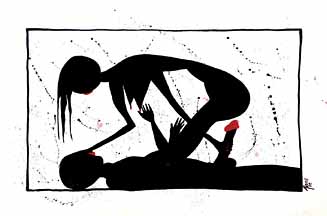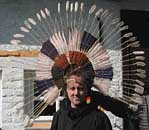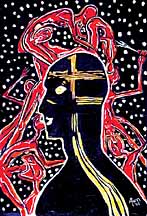DISPATCH SPRING 2004 |
||||
|
alann de vuyst International art that takes on the innocence of tribal sensitivity and tells us of the heartless ruggedness of urban sophistication. The artist was born in 1959 in Aalst, Belgium and trained for four years at St. Lukas art school in Brussels. He exhibits in Belgium, Brazil, Sri Lanka, Nepal, Thailand, Japan and India and his work can be seen currently as part of the Tom of Finland Collection at
The Erotic Museum in Hollywood.
Time tends to let people forget their ancestral images. We Westerners had the Visigoths, Celts and Vikings, to name a few, who used patterns similar, if not identical to the Aborigines. Our own heritage is rich — just think of the caves of the
Neolithic era in Altamira, Spain or the famous Cerne Abbas Giant of Dorset in the UK. When I saw the latter, it gave me the feeling I wasn’t painting anything new but merely continuing what had always been there. It is pleasant to discover how other cultures used to worship the lingam, or phallus, as a source of fertility and divine power. We all made primitive drawings as children in which we would draw only the essential lines for fingers or legs and that’s what attracted me to tribal art: the simple but accurate lines and dots and striking colors that make it all complete. All this bigotry and falsification has become the central drive for my work, to (re)create art that can defy Taliban censorship! My art still gets censored in Europe as well as in Asia. Of course the fact that I add some homoerotic ingredients into my work doesn’t improve the situation. The whole thing started after my first visit to Brazil where I met autodidact painters in the northeastern states and in particular, in Cuiaba, capital of Mato Grosso. The art they made was called Arte Primitivo or arte caboclo. A caboclo is someone with Indian blood or who lives as an Indian at the fringes of the jungle. In some ways one can compare their art with the naive art that emerged in Europe with Le Douanier Rousseau. Only their art is more indigenous with a much looser style and more vividly colored. I was then painting semi-realistic works in the studio of the Federal University of Mato Grosso State. When I returned to my native Belgium all that I had seen lingered in my mind. I wanted to get away from the harsh topics of politics and themes like AIDS which I used to paint in Europe. My stay with the Xavante Indians, who adopted me in their clan through a blood pact, gave me an extra boost to steer away from anything realistic on canvas.
1995 took me back to Brazil where I witnessed a festival called Festa do Divino, the Feast of the Holy Spirit, in the city of Perinopolis. Basically a replay of the Crusades (where the crusaders were the victors.) During a two week period masked men on horses rampage through the hilly streets of the city in authentic costumes. They wear masks representing the faces of bulls; their huge papier-mache horns decorated with paper flowers and garlands. The drunken participants play out scenes of violence such as settling a score with a foe or publicly raping a maiden or two. This debauchery inspired me to sketch the men hanging from the belly of their stallion and being sodomized by it, or an act of fellatio between mount and rider. In Thailand in 1996 I was still following that lead and thus came to life my reptile-like creatures. The men-bulls had simply lost their horns but were still fornicating with anything they could lay their claws on. From that moment on they led their own life and I invented more creatures—demon or godlike—sometimes in a Aztec codex-like setting, sometimes in a futuristic environment or in a tantric dance. — Alann de Vuyst A Native American artist said, “The best way to preserve tradition is to continuously reinvent it.” This artist's images shown on this page are currently offered through the Erotic Art Gallery. |


